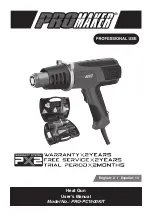
4
REV. 8/14
HOW TO USE THE GB706LGP
WARNING:
Operator
MUST
read and understand all warnings and cautions.
WARNING:
It is required that eye protection and hearing protection be worn during operation.
WARNING:
Do not pull rivet in the air. Personal injury from fastener ejecting may occur.
WARNING:
Do not bend tool if stuck on fastener.
WARNING:
Do not pull pin unless inserted in sheet. Severe personal injury may result.
WARNING:
Be sure powerunit is disconnected before cleaning, or when replacing worn or damaged
components. Severe personal injury may occur if power source is not disconnected.
WARNING:
Be sure there is adequate clearance for tool and operator's hands before
proceeding. Keep fingers clear of any moving parts. Keep fingers clear from
fasteners and installed materials. Severe personal injury may result.
WARNING
:
The balance of this tool is designed for horizontal use and is not suited for any other ap-
plication. Gage Bilt will be pleased to advise for your specific application.
CAUTION:
Hydraulic powerunits that are not equipped with relief valves and that deliver high pres-
sure for the “PULL” and “RETURN,” are not recommended and may be dangerous.
CAUTION:
Do not use beyond design intent.
1. Set power supply to the recommended pressure, 5,600 psi (386.1 bar) for the pull and 2,400 psi
(165.4 bar) for the return.
2. Connect hydraulic coupling-male (585047), hydraulic coupling-female (585038) and male
connector (585044) to power supply.
WARNING:
Ensure hydraulic hoses are securely connected to avoid possible hose whipping.
3. To ensure piston assy (705210) is in the full forward position, Cycle tool.
PRINCIPLE OF OPERATION
When the tool is connected to the power supply, depressing the electric actuator will simultaneously
start the pump and shift the directional valve. Hydraulic oil is then forced up and into the front side
of the head cylinder assy, causing the piston to move to the rear position. The internal components
of the tool are also moving with the piston to start the fastener installation. As the piston nears the
end of its stroke, it exposes flats on the unloading valve. These flats relieve the oil pressure and al-
lows the oil to return to the reservoir tank. When the fastener installation is completed, the electric
actuator is released causing the directional valve to shift back to its original position. Hydraulic oil is
then directed to the rear of the piston moving it and the internal components of the tool forward to
their original position.


























